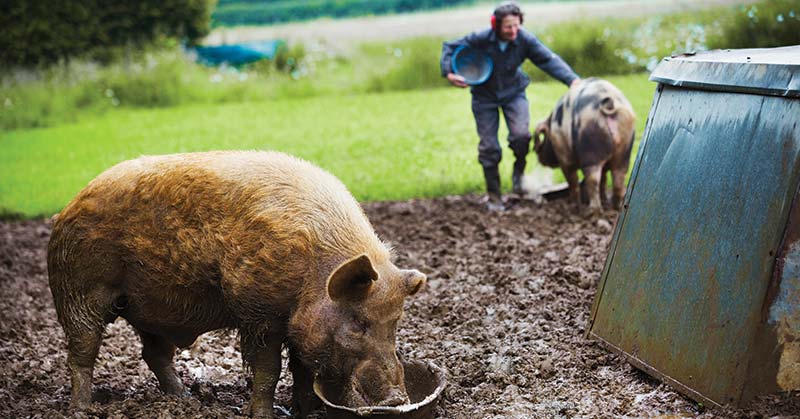Composting pig manure is an environmentally friendly and highly effective way to convert organic waste into a valuable soil amendment for gardening and farming. This natural process involves the breakdown of manure through microbial activity, resulting in a nutrient-rich compost that enhances soil health and fertility. The key to successful composting lies in understanding the right methods and maintaining the balance of essential elements.
So, let’s dive into the steps of transforming pig manure into black gold for your garden!
Step 1: Setting Up Your Compost Pile
Begin by selecting a suitable location for your compost pile or bin. It should be in a well-drained area with easy access to water. Create a base layer with coarse materials like small branches or straw to aid in aeration and drainage.
Then, add a layer of pig manure, followed by a layer of carbon-rich materials such as dry leaves, straw, or sawdust. These layers help balance the nitrogen-rich manure with carbon, which is crucial for successful composting.
Step 2: Managing the Carbon-to-Nitrogen Ratio
The carbon-to-nitrogen (C:N) ratio is vital in composting. Pig manure is high in nitrogen, so it’s essential to balance it with carbon-rich materials. The ideal C:N ratio is about 25-30:1 (carbon to nitrogen). This balance ensures efficient breakdown of materials and minimizes odors.
Step 3: Regularly Turning the Pile
Aeration is crucial for composting. Regularly turning the compost pile introduces oxygen, which is necessary for the microbes to break down the organic matter. Aim to turn the pile every 2-4 weeks.
This also helps to distribute heat and moisture evenly throughout the pile, speeding up the composting process.
Step 4: Monitoring Moisture and Temperature
The compost pile should be moist, but not overly wet. The consistency should be like a wrung-out sponge. If the pile is too dry, add water; if too wet, add more carbon-rich materials. Additionally, monitor the temperature of the pile. It should heat up to around 130-150°F, which is essential for killing pathogens and weed seeds.
Step 5: Knowing When It’s Ready
Composting pig manure typically takes 3-6 months. You’ll know it’s ready when it has a dark, crumbly texture and an earthy smell, with no resemblance to the original manure. This compost can be used as a soil conditioner, improving soil structure, moisture retention, and nutrient availability.
Additional Tips and Considerations
- Safety Measures: Always wear gloves when handling manure and wash your hands thoroughly afterward.
- Balancing Ingredients: Keep a stock of carbon-rich materials handy to adjust the pile as needed.
- Avoiding Pests: Ensure your compost bin is well-constructed to prevent rodents and other pests.
- Usage: Fully composted pig manure is excellent for enriching garden beds, improving soil in vegetable gardens, and as a top dressing for lawns.
Conclusion
Composting pig manure not only provides a nutrient-rich soil amendment but also contributes to sustainable waste management. By transforming what would be waste into a valuable resource, you play a part in creating a more sustainable and eco-friendly gardening practice.
FAQs on How to Compost Pig Manure
Q: Is pig manure safe to use for composting?
A: Yes, pig manure is safe for composting. It’s a rich source of nutrients for soil. However, it’s important to compost it properly to kill harmful pathogens.
Q: What materials should I mix with pig manure for effective composting?
A: Mix pig manure with carbon-rich materials like straw, sawdust, or dry leaves. This helps balance the nitrogen in the manure and aids in the composting process.
Q: How long does it take to compost pig manure?
A: Typically, it takes about 3 to 6 months to fully compost pig manure. The time can vary depending on factors like temperature, moisture, and aeration.
Q: How do I know when the compost is ready to use?
A: Compost is ready when it’s dark, crumbly, and has an earthy smell. It shouldn’t have any foul odor or recognizable manure pieces.
Q: Can composting pig manure cause a bad odor?
A: If composted correctly, pig manure should not cause a strong bad odor. Proper aeration and the right carbon-to-nitrogen ratio help minimize odors.
Q: What is the ideal carbon-to-nitrogen ratio for composting pig manure?
A: Aim for a carbon-to-nitrogen ratio of about 30:1. This means mixing one part nitrogen-rich pig manure with about 30 parts carbon-rich materials.
Q: Can I use composted pig manure in vegetable gardens?
A: Yes, once fully composted and properly processed, pig manure can be a valuable nutrient source for vegetable gardens.
Q: What are the main benefits of composting pig manure?
A: Composting pig manure enriches the soil, reduces waste, minimizes methane emissions from manure piles, and recycles nutrients back into the land.
Q: How often should I turn the compost pile?
A: It’s recommended to turn the compost pile every few weeks to ensure proper aeration and speed up the composting process.
Q: Are there any health risks associated with composting pig manure?
A: If not handled properly, there can be health risks due to pathogens in manure. Ensure the compost reaches a high enough temperature and is fully processed before use to minimize risks.




